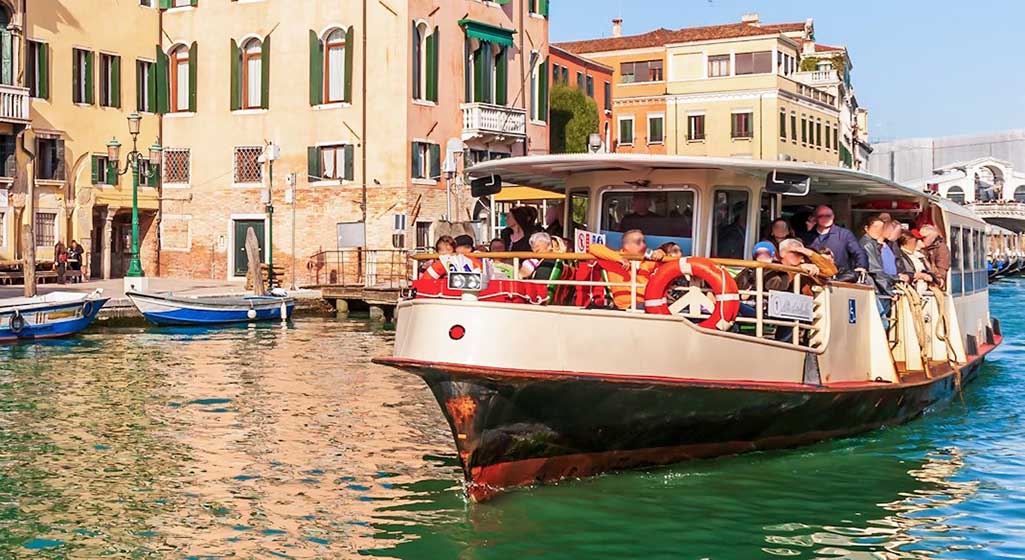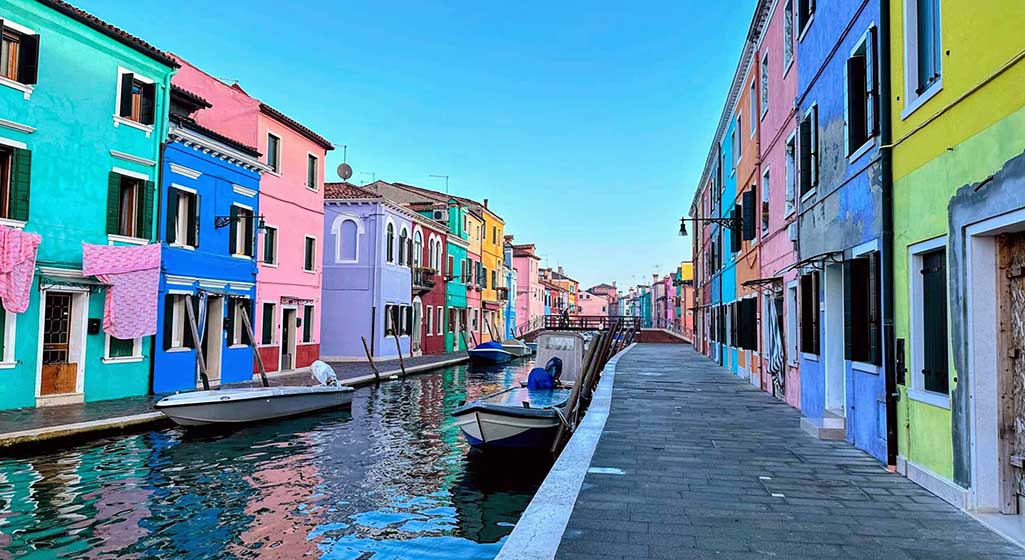As the morning sun casts its golden glow upon the tranquil canals, and gondolas create ripples in the winding water lanes, Venice awakens with its unique allure, captivating every traveler’s senses. This city, composed of 118 islands connected by over 150 canals and more than 400 bridges, is both enchanting and historically rich. From the world-famous St. Mark’s Square to the lesser-known gems of Murano, Burano, and Torcello, Venice offers both iconic landmarks and hidden treasures.
I’ll guide you through a day that perfectly balances Venice’s “star attractions” with its lesser-known wonders. In this watery maze, getting lost is the true essence of travel.
1. Early Morning Start: Begin Your Venice Journey at St. Mark’s Square
1.1 St. Mark’s Square (Piazza San Marco): The Starting Point
Dubbed by Napoleon as “the most beautiful living room in Europe,” St. Mark’s Square is undoubtedly the heart of Venice. Surrounded by grand architecture — including the majestic St. Mark’s Basilica, the elegant Clock Tower, and the gothic splendor of the Doge’s Palace — every corner of the square whispers stories from centuries past. The square comes alive early in the morning with soft golden sunlight casting long shadows, ideal for photography and quiet reflection.
- Recommended Activity: Arrive around 8 AM to avoid crowds and capture the ethereal morning light on St. Mark’s Basilica. Don’t miss climbing the Campanile (bell tower) — the view over the lagoon and terracotta rooftops is unforgettable.
- Travel Tip: Entry to St. Mark’s Basilica is free, but the museum, Pala d’Oro, and treasure room require tickets. Book online in advance to skip long queues, especially during peak travel season.
1.2 Doge’s Palace (Palazzo Ducale): A Symbol of Power
Located adjacent to the Basilica, the Doge’s Palace stands as a powerful reminder of Venice’s once-mighty maritime empire. With its blend of Gothic and Renaissance styles, lavish Golden Staircase, and the haunting Bridge of Sighs leading to the old prison, this palace is both beautiful and haunting. Walking through its chambers is like stepping back into the era of the Venetian Republic.
- Visiting Tip: The “Secret Itineraries Tour” is a must for history buffs, offering exclusive access to secret council rooms, torture chambers, and Casanova’s prison cell — an unforgettable dive into the political intrigue of old Venice.
- Opening Hours: Typically open from 9:00 AM to 7:00 PM, with extended hours in summer. Lines can be long, so pre-booking your ticket is highly recommended to make the most of your day.
2. Navigating the Water Lanes: A Double Experience of Gondola and Vaporetto
2.1 Vaporetto: Venice’s “Water Bus”
The Vaporetto is the backbone of Venice’s public transport system, gliding through the Grand Canal like floating buses. Line 1 is especially scenic, stretching from the Santa Lucia Train Station through the historic heart of Venice — passing iconic sights such as the Rialto Bridge, palatial waterfront homes, and the lively atmosphere of St. Mark’s Square.
- Ticket Tip: A single ride costs 7.5 EUR, but frequent users will benefit from the 24-hour (or multi-day) transport passes, which allow unlimited rides and can be used on other ACTV transport services including buses to the mainland.
- Travel Tip: Sit or stand in the back section of the Vaporetto, which is open-air and perfect for photography. Early morning rides offer peaceful reflections on the water, while twilight cruises reveal a more romantic Venice, softly lit by lanterns.

2.2 Gondola: The Romantic Symbol of Venice
Nothing captures the spirit of Venice more than a ride on a gondola. Though often seen as touristy, when chosen wisely, it can be a serene and unforgettable experience. Floating under arched bridges and alongside weathered buildings that rise directly from the water, you’ll understand why poets and painters fell in love with the city.
- Money-saving Tip: Shared gondola rides — available near major landmarks such as the Doge’s Palace or Rialto Bridge — reduce the cost significantly (approx. 20 EUR per person for a 6-passenger gondola) while still offering the full experience.
- Recommended Route: Embark near Campo San Barnaba in the Dorsoduro district for a less crowded and more authentic route that takes you through tranquil canals before reaching the iconic Grand Canal. This quieter side of Venice offers the perfect setting for romantic photos and peaceful moments.
3. Midday Leisure: From Rialto Bridge to Hidden Baroque Churches
3.1 Rialto Bridge (Ponte di Rialto): The Oldest Canal Crossing
As the oldest and most famous bridge crossing the Grand Canal, the Rialto Bridge dates back to the 16th century. This architectural marvel has arched walkways flanked by quaint shops, making it a hotspot for photography, sightseeing, and people-watching. Standing on the bridge, you can admire the colorful palaces lining the canal and take in the lively atmosphere of Venice’s most iconic waterway.
- Nearby Recommendations: On the west side, visit the Rialto Market for fresh local seafood and unique souvenirs.
- Food Tip: Check out Cantina Do Spade, a local “Bacaro” (Venetian wine bar), where you can enjoy a Spritz paired with fried seafood.
3.2 Chiesa di San Martino: A Hidden Baroque Gem
Tucked away in the Castello district, this unassuming Baroque church is a stunning hidden treasure. Its gold-leaf altar paintings and serene atmosphere transport you to another time, offering a peaceful retreat away from the bustling tourist crowds. The soft lighting inside creates a magical effect, illuminating the intricate frescoes and statues.
- Visiting Tip: Entry is free, but keep noise to a minimum. Afternoon visits are ideal as there are fewer visitors.
4. Afternoon Exploration: Discovering Hidden Islands
4.1 Murano Island: A Thousand-Year Legacy of Glass Art
Famous for its world-renowned glassmaking, Murano Island is the birthplace of this delicate and intricate art form. The island is just a 15-minute Vaporetto ride from Fondamente Nove, and as you approach, you’ll see the sparkling beauty of the glass factories reflected in the water. Murano’s rich tradition of glassmaking dates back to the 13th century, and the island is home to a number of workshops that preserve this ancient craft.
- Must-See:
- Glass Museum (Museo del Vetro): Discover the evolution of glass art over the centuries.
- Glass Workshops: Watch the live glassblowing process; some workshops offer free entry.
- Travel Tip: Try to avoid peak tourist hours (10:00 AM to 12:00) when group tours are at their busiest.
4.2 Burano Island: A Colorful Fisherman’s Paradise
A 45-minute Vaporetto ride takes you to Burano, a picturesque fishing village famous for its colorful houses and exquisite lace-making. The brightly painted houses, each in a different shade, line the canals, creating a whimsical and photogenic backdrop. The island’s charm lies in its vibrant colors, which have become a trademark of Burano, and the sense of peace and simplicity that pervades the area.
- Photography Tips:
- Via Baldassarre Galuppi: The main street, lined with vibrant houses, is perfect for capturing shots of the island’s colorful facades and reflections in the canals.
- Lover’s Bridge: A quaint little bridge that offers an atmospheric setting for photos, particularly during the golden hour when the soft light bathes the island in a warm glow.
- Food Recommendation: Riva Rosa restaurant is famous for its seafood pasta and the homemade sweet “Bussolà.”

4.3 Torcello Island: The Birthplace of Venice
A 10-minute boat ride from Burano, Torcello is the earliest inhabited island in Venice and is now sparsely populated, offering a peaceful atmosphere steeped in history. This tranquil island was once the heart of the Venetian Republic, and its quiet ruins and ancient landmarks tell the story of its once-great influence.
- What to See:
- Santa Maria Assunta Cathedral: Known for its stunning Byzantine mosaics, the cathedral is a masterpiece of medieval art and architecture, depicting biblical stories in rich, golden tones.
- Attila’s Throne: Legend has it that Attila the Hun sat on this stone chair during his brief visit to the island. It’s a popular photo spot for visitors, adding to the island’s mysterious aura.
- Atmosphere: The island’s tranquility feels like time stands still, making it an ideal place for a leisurely walk.
5. Evening Return: The Finale in the Sunset Glow of Venice’s Canals
Take the last Vaporetto back from Burano or Torcello, cruising under the Venetian sky as the sunset paints the canals in hues of orange and pink. It’s the perfect way to conclude a day of exploration.
- Photography Tip: Watch for moments when the light reflects off the church towers, bell towers, and shimmering water — these are perfect for a final photo op.
- Dinner Tip: End your day in the Cannaregio district with a local Bacaro, where you can savor a plate of cuttlefish pasta paired with a glass of wine, rounding off your journey in Venice.
6. Rediscover the Joy of Slow Travel in the Heart of the Water City
Venice isn’t just about the classic landmarks; it’s a city meant to be explored slowly, lost within its intricate network of alleys and canals. In this car-free city, where the rhythm of your steps and the sound of the gondolas provide the tempo, take your time to discover the true meaning of travel. Let the day unfold, and may you find peace and beauty in the winding lanes and shimmering waters of this timeless city.




